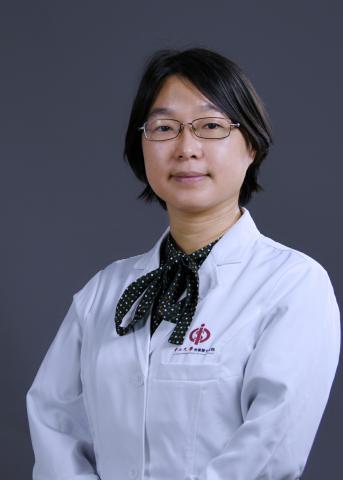
Dr. Liu is interested in how circadian clocks regulate physiology and how disruption of clocks accelerates aging. The circadian clock is a highly conserved physiological timing mechanism that allows organisms to adapt to the day-night cycle. The internal molecular clock is composed of interlocked transcription-translation loops. The central clock lies in the suprachiasmatic nucleus while there are also clocks clicking in the peripheral tissues. Clock component gene anomalies are associated with sleeping disorder, autism, metabolic diseases, cardiovascular diseases, cancer and reproductive difficulties. Shift workers and flight attendants have increased the risk of irregular menstrual cycles, abortions, breast cancer or prostate cancer risk. In mouse model’s disruption of circadian component, genes lead to accelerated aging, shorter lifespan, diabetes, cataract, arthropathy, infertility, cardiovascular diseases, impaired memory, and cell senescence. We used the promoter that controls the expression of Steroidogenic Factor-1 (SF1) to drive Cre-recombinase mediated deletion of the Bmal1 gene, known to encode an essential component of the circadian clock (SF1-Bmal1-/-). The resultant SF1-Bmal1-/- females display embryonic implantation failure, which is rescued by progesterone supplementation, or bilateral or unilateral transplantation of wild-type ovaries. This study is published in PNAS and highlighted by Nature Review Endocrinology. Gene knockout mouse models provide convenient models to study the relationship between disrupted circadian rhythm and the wide spectrum of diseases.
The pervasive early-aging pathologies caused by disrupted circadian clocks urged Dr. Liu into Conboy lab, an aging research lab in the University of California, Berkeley in 2015. As a postdoctoral researcher she was supported by the Calico Longevity Fellowship, hunting for rejuvenating factors for aged progenitor cells. Heterochronic parabiosis (surgically suturing a young mouse to and old mouse) can be taken as transplantation of a whole animal to the other. The old parabionts are reported to live longer with enhanced muscle regeneration and neurogenesis, suggesting that young circulatory system might reverse aging. Using the bioorthogonal noncanonical amino acid tagging technology enables detecting protein candidates in the young environment that have the rejuvenating potential. This study is published in Nature Communications.
Recent breakthroughs in aging research have shown that it is possible to slow aging and extend the healthy lifespan of laboratory animals, among which is the discovery of the role of the mTOR signalling pathway in aging processes. Rapamycin, the drug used to suppress immune rejection in the transplant surgery successfully prolonged lifespan of animal models including Bmal1-/- mice. Aging is usually associated with chronical inflammation and loss of immune homeostasis, which is recapitulated in animal models of disrupted circadian rhythm. For example, Alzheimer’s disease is accompanied by an age-related increase in proinflammatory cytokines. Unfortunately, these signals do not trigger beneficial immune activity toward the mistakenly accumulated plaques. Restoring immune homeostasis might be a new target to treat Alzheimer’s and other aging diseases such as diabetes, cancer, and degenerative diseases.
Education:
BS - 1997, microbiology and biotechnology, China Pharmaceutical University
MS - 2003, molecular biology, Institute of Genetics and Developmental Biology
Chinese Academy of Sciences
PhD - 2012, circadian biology, University of Wisconsin-Madison
Postdoc - 2012-2014, neuroscience and stem cell biology, University of Wisconsin-Madison
Postdoc - 2015-2017, aging study, University of California, Berkeley
Funding
2018 National Natural Science Foundation of China 31741069
2017-2020 startup funding for ‘100 Talents Plan’ in Sun Yat-sen University.
Publications
· Yan Liu, Michael J. Conboy, Melodv Mehdipour, Yutong Liu, Thanhtra P. Tran, Aaron Blotnick, Prasanna Rajan, ThalieCavalcante Santos and Irina M. Conboy. (2017) Application of Bio-Orthogonal proteome labeling to cell transplantation and heterochronic parabiosis. Nature Communications Sep 21;8(1):643. doi: 10.1038/s41467-017-00698-y. Impact factor 11.32
· Rebo J, Mehdipour M, Gathwala R, Causey K, Liu Y, Conboy M, Conboy I. (2016) A single heterochronic blood exchange reveals rapid inhibition of multiple tissues by old blood. Nat Commun 7: 13363. Impact factor 11.32
· Liu Y, Johnson BP, Shen AL, Wallisser JA, Krentz KJ, Sullivan R, Drinkwater N, Schuler L., Bradfield CA. (2014) Loss of BMAL1 in ovarian steroidogenic cells results in implantation failure in female mice. Proc Natl Acad Sci U S A 111: 14295-14300. Impact factor 9.7
Research highlighted by Nature review endocrinology. Impact factor 15.4
· Johnson BP, Walisser JA, Liu Y, Shen AL, McDearmon EL,Schook AC, Takahashi JS, Bradfield CA. (2014) Hepatocyte
circadian clock controls acetaminophen bioactivation through NADPH-cytochrome P450 oxidoreductase. Proc Natl Acad Sci U S A 111: 18757-18762. Impact factor 9.7
· Williams EC, Zhong X, Mohamed A, Li R, Liu Y, Dong Q, Ananiev G, Zhang S, Chang Q. (2014) Mutant astrocytes differentiated from Rett syndrome patients-specific iPSCs have adverse effects on wild-type neurons. Hum Mol Genet 23: 2968-2980. Impact factor 5.99
· Chernoff N, Rogers EH, Zehr RD, Gage MI, Malarkey DE, Bradfield CA, Liu Y, Rosen MB.et al. (2011) Toxicity and recovery in the pregnant mouse after gestational exposure to the cyanobacterial toxin, cylindrospermopsin. J Appl Toxicol 31: 242-254. Impact factor 3
· Hayes KR, Zastrow GM, Nukaya M, Pande K, Glover E, et al. (2007) Hepatic transcriptional networks induced by exposure to 2,3,7,8-tetrachlorodibenzo-p-dioxin. Chem Res Toxicol 20: 1573-1581. Impact factor 3.5
· Liu Y, Guo C, Ren H, Chen F. (2004) Isolation and characterization of a novel cis-acting sequences regulating root-specific gene from Daucus carota L. Chinese Science Bulletin 49:2393-2398. Impact factor 1.6
POSTERS IN CONFERENCE
Liu Y, Krentz K, Sullivan R, Shen A, Wallisser J, Moran S, Chris Bradfield. Different cell types contribute to the impaired fertility of male and female Mop3 mutant mice. (2011 McArdle symposium).
Johnson B, Walliser J, Liu Y, Bradfield C. The hepatocyte clock regulates P-450 dependent acetaminophen metabolism. (2011 McArdle symposium)
INVITED TALKS
Different cell types contribute to the impaired fertility of male and female Mop3 mutant mice. 2012/7, Max Planck Institute of Biophysical Chemistry, Goettingen, Germany.
Using Click Chemistry to Hunt Rejuvenating Factors. 2016/4, Berkeley Stem Cell center, Asiloma, CA, USA
Email Address:liu92@mail.sysu.edu.cn
